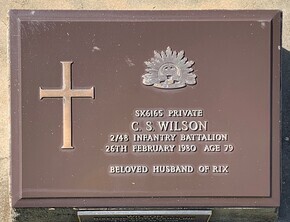WILSON, Charles Stanley
| Service Number: | SX6165 |
|---|---|
| Enlisted: | 21 June 1940, Adelaide, SA |
| Last Rank: | Private |
| Last Unit: | General Details Depot |
| Born: | Leeds, England, 26 July 1900 |
| Home Town: | North Adelaide, Adelaide, South Australia |
| Schooling: | Not yet discovered |
| Occupation: | Salesman |
| Died: | 26 February 1980, aged 79 years, cause of death not yet discovered, place of death not yet discovered |
| Cemetery: |
Centennial Park Cemetery, South Australia Derrick Gardens, section South A Path 39, Plot 735B. |
| Memorials: |
World War 2 Service
| 21 Jun 1940: | Involvement Private, SX6165 | |
|---|---|---|
| 21 Jun 1940: | Enlisted Adelaide, SA | |
| 21 Jun 1940: | Enlisted Australian Military Forces (WW2) , Private, SX6165, General Details Depot | |
| 21 Jun 1940: | Enlisted Australian Military Forces (WW2) , 2nd/48th Infantry Battalion | |
| 27 Jun 1945: | Discharged | |
| 27 Jun 1945: | Discharged Australian Military Forces (WW2) , Private, SX6165, General Details Depot |
Loyal Yorkshireman.
Charles was born in the Yorkshire town of Leeds, England on the 26th July 1900 to George William Wilson. His enlistment papers show he spent time in the Royal Airforce before living in North Adelaide and working as a salesman.
Just days prior to his 40th birthday, on the 21st June 1940, Charles enlisted to serve in WWII nominating his father, still living in the United Kingdom, as his next of kin. Charles was allocated the number SX6165 and placed in the newly formed 2/48th Battalion, training in the Adelaide Hills area of Woodside. He had met Caroline ‘Judy’ Jane Blanche Winter (nee Oswald), a divorcee, prior to heading overseas, with this relationship developing during his time in the Middle East.
Following pre-embarkation leave, Charles sailed from Adelaide on the Stratheden on the 7th November ’40, arriving in the Middle East on the 17th December. Conditions were in stark contrast to his civilian employment and by the end of ’41 Charles developed tonsilitis. He also acquired a new, unofficial title of which he and his fellow soldiers were particularly proud. In an attempt to demoralise the soldiers, German planes dropped leaflets urging the men to surrender as they were living ‘like rats’ in their hand-hewn, dusty dugouts. Contrarily, the men immediately seized on the taunt, calling themselves rats of Tobruk, which became a symbol of honour and respect.
During the lead-up to the attack on El Alamein, in September ’42 Charles fractured six ribs and spent almost a month recovering before he was able to re-join his battalion. Unfortunately, in January the following year Charles then contracted hepatitis. The lure of a return to Australia was constantly the topic of rumours and speculation. Finally, the remaining soldiers of the 2/48th returned to Australia via Melbourne, arriving early in February.
On his return to Adelaide, Charles married Caroline on the 27th February ’43, changing his next of kin details to her home in North Adelaide By that stage, both age and the harsh demands of service deemed Charles to restricted medical fitness and he was transferred to the 2/2 Battalion for Garrison duty. Poor health, fatigue and indigestion continued to make life challenging. Following several bouts of renal colic and hospitalisation, Charles was finally discharged from the General Details Depot on the 27th June ’45.
He and Caroline (‘Judy’) continued to live in North Adelaide until Judy’s death, aged 80, on the 2nd September ’62. She was buried at Centennial Park Cemetery in the South East Rose bed S5 Position 23.
Charles married again to Rixende (Rix) Edith Caroline.
Aged 79, Charles died on the 26th February 1980 and was buried in the Centennial Park Cemetery, fittingly in the Derrick Gardens, section South A Path 39, Plot 735B. Rix lived to be 91 and died on the 28th April 2009. She now also rests with Charles in the Derrick Gardens.
Researched and written by Kaye Lee, daughter of Bryan Holmes SX8133, 2/48th Battalion.
Submitted 17 July 2025 by Kaye Lee











